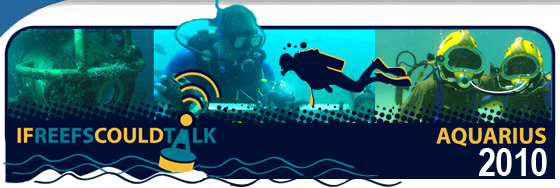Error processing SSI file
|
Aquarius 2010: If Reefs Could Talk
Have you ever wondered what it would be like to live underwater? Well, from October 12-21 you can find out by tuning in to daily broadcasts shot live from an undersea research lab, the only one of its kind in the world. The Aquarius lab is located off the coast of Key Largo, 60 feet below the surface at the base of one of the many beautiful coral reefs comprising the Florida Keys National Marine Sanctuary. The scientific researchers or "aquanauts" (meet the team) that live in Aquarius, as well as scientists operating from the surface, are sharing their experience and intimate knowledge of the ocean while performing their latest mission, Aquarius 2010: If Reefs Could Talk. In addition to the live shows, the aquanaut team will keep followers continually updated on the mission's progress through their expedition blog, Twitter and Facebook pages.
Educating the Next Generation
Aquarius 2010: If Reefs Could Talk incorporates live educational broadcasts into the daily lives of the aquanauts and associated scientists in order to bring the science of ocean conservation and the underwater world to communities nationwide. Scientists and educators are working together to communicate themes of biodiversity, climate change, and field science technology with the goal of creating a more ocean literate public. Several schools and aquariums even have the opportunity to interact directly with the aquanauts while they are living in Aquarius. The National Association of Black Scuba Divers (NABS) and the Multicultural Education for Resource Issues Threatening Oceans (MERITO) will be working with NOAA's Office of National Marine Sanctuaries to help with mission programming targeting African American and Latino communities. Check out our broadcast schedule for more info.
A Mission of Discovery
Aquanaut Research from the Sea Floor
Although the aquanauts will be taking the time to conduct live broadcasts, their main focus is still the science behind the mission.They are studying the behavioral interactions of fishes that live in a range of coral habitats across the Conch reef area. Since the aquanauts can use saturation diving to stay underwater for much longer than regular divers, they can collect significantly more data than surface based divers over the same time period. All this information will help marine biologists everywhere have a much better understanding of coral reef communities and how diverse species interact to find prey and avoid predators.
Science from the Surface
Two other teams of scientists will be conducting research from the surface. One will be using the latest in sonar technology to study how fish distributions change over time across wider areas of the reef then the aquanauts can venture. In addition, they will be using what is essentially a camera that uses sound instead of light to record fishes that move from one habitat to another to feed and find prey. The other team of scientists will conduct fish behavior surveys farther from Aquarius as well as place several video cameras around the reef to see how all the fish interact in different habitats over time. Together, all of the data collected on this mission will paint a unique and comprehensive portrait of reef fish communities and their interactions across the coral reef landscape.
|



